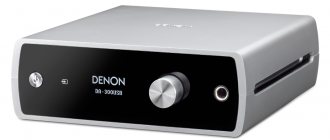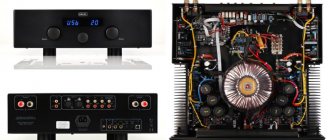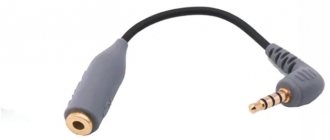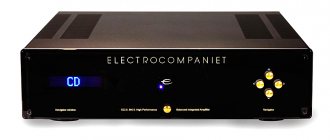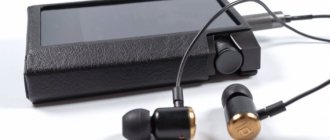Original review: https://www.salonav.com/arch/2021/06/ps-audio-perfectwave-sacd-transport-i-directstream-dac.htm
The manufacturer considers this combination, which appeared at the end of last year, to be the apotheosis of digital technology. It contains a lot of engineering solutions that are designed to take the quality of playback to a fundamentally different level.
The set is undoubtedly addressed to demanding music lovers who do not want to switch to “disembodied” technologies. We will look at it from this angle.
Manufacturers love to come up with loud and promising names for their developments, but behind this there is rarely anything more than a simple calculation to intrigue a potential buyer. With PerfectWave (“ideal waveform”) the story is completely different. Paul McGowan, the head of the American PS Audio and its main developer, released the Genesis device back in 1996, in which he used a technology called Digital Lens. His task was to get rid of jitter when playing CDs. In this case, a high level of jitter can occur for several reasons: poor-quality disk stamping (fuzzy pit edges), contamination, scratches, beating during rotation, defocusing of the laser beam, etc. Some of the mechanical aspects can be eliminated by using expensive top-loading drives, magnetic clamps, structural damping, etc. But what to do with the possible shortcomings of the CDs themselves? McGowan solved this problem radically by isolating the digital signal from the transport: the reproduced information first goes into the buffer memory, and from there it is retrieved via the I2S bus synchronized by a precision clock generator. In this case, clock pulses isolated from the read data stream (and this is the main source of jitter) do not enter the buffer and are not used in the future.
Description of the external DAC PS Audio PerfectWave DAC MkII with Bridge
This model from the American company PS Audio is a unique product that impresses with the highest sound quality and combines a DAC, media player and preamplifier. The MkII version received a number of changes related to an improved digital processor board, more advanced power supply (added 11 local power supplies for each section of the circuit), lower jitter and updated software. The remote control has become more functional.
The body with smooth rounded edges is made of steel and aluminum. On the right side of the front panel there is a color touchscreen. The varnished top cover is made of MDF.
The conversion of digital to analog is carried out by the Wolfson WM8741 converter. There is a Bridge network card module that supports the DLNA protocol and accepts web radio and other streaming content from the Internet, as well as server and PC files with a resolution of up to 32-bit/192 kHz. The touch screen controls the device and displays music album covers. The model can also handle preamplifier functions, as it is equipped with volume and balance controls and an input selector. The device can increase the sampling frequency of any source signal up to 192 kHz. There is a Digital Lens circuit, which is a large-capacity buffer with a precision clock generator that eliminates jitter. Native X mode includes this buffer and lowers the jitter level below one picosecond for any source. Digital Lens technology is also used in the Bridge module. You can use one of five digital filters or let the microprocessor do it automatically. The analog section uses discrete transistors, Nichicon capacitors and other precision elements. A signal phase switch is provided.
Inputs: two HDMI connectors transmitting a signal in accordance with the internal I2S bus standard; balanced AES/EBU; optic; coaxial; USB port that operates in asynchronous mode and accepts audio in resolutions up to 24 bit/192 kHz. There are Ethernet and USB interfaces for the network card, as well as a slot for SD cards. Outputs: linear RCA and balanced XLR. You can rename inputs by entering a name using the touch screen, and you can also select their sample rate and filter type.
This device represents a new class of audio products and combines the capabilities of digital and high-quality analog sound, while remaining a multifunctional device.
PS Audio Perfect Wave DAC MkII - The result of the upgrade is amazing sound
The previous version of the PerfectWave DAC is familiar to us; PWD Mk II, externally indistinguishable from its predecessor, has been significantly redesigned
Digital world
around us has become dense and almost tangible, and more and more people in this sea of information feel like fish in water. If three years ago one could doubt the quality of digital music obtained not from optical media, now we have tasted HD audio, which is already too cramped on disks. The PWD Mk II DAC is a new era media device in Hi-Fi. It is ready to receive a digital stream from any source: CD transport, network player, music server, computer, or can itself act as a network player (with the Bridge module on board) and access any DLNA-compatible server included in home network, or play streams directly from the Internet.
But all this relates to, so to speak, the computer side of its essence, and functional analogues can be found for much less money; We are more interested in the PWD Mk II as a Hi-Fi component. It was to improve the sound quality that its modernization was undertaken.
With PWD Mk II we have risen to a new height of naturalness and adequacy to the original - live sound
The list of improvements to the PWD Mk II, available on the PS Audio website, contains about a dozen items, and all of them are in one way or another aimed at combating jitter and reducing the level of noise generated by digital circuit elements (see sidebar).
Richness and naturalness
Like many component DACs, the PWD Mk II gives you the ability to play with your audio through selectable oversampling rates and digital filters. When reading a CD on its sister PS Audio PerfectWave Transport, connected via the I2S logical bus implemented on the HDMI connector, we liked the Native mode (44.1 kHz) most of all - others, although they draw details more clearly, introduce artificiality into the sound. But the innovation of the device - the “sound lens” - is something special. She works wonders with sound: it becomes alive, mobile, quivering; the music stage fills with air, the space becomes larger. We carried out a meticulous comparison of source options using CD Prokofiev
.
Romeo and Juliet.
Suites Nos. 1&2 (performed by the Oslo Philharmonic Orchestra conducted by Maris Jansons) and its clone on the PC hard drive.
The track " Montagues and Capulets
" carries the most difficult tasks to reproduce, placing demands on both microdynamics and the scope of the dynamic range, as well as on the timbral fidelity of the voices of the orchestra's instruments. It seems that all this is forever recorded on the optical disc, but time after time, with another excellent component in our test, the recording reveals itself more and more fully. With PWD Mk II we have risen to a new height of naturalness and adequacy to the original - live sound.
Similar metamorphoses occur when choosing the NativeX mode with other sources. We do not undertake to claim that when connecting the Esoteric X-03 via an S/PDIF connection and a PC via USB, the sound quality is the same, but the difference is significantly less than that of other component DACs; The “sound lens” levels it out even more, if not in terms of formal indicators (detail, signal/noise ratio, etc.), then in terms of naturalness and emotionality.
The whole point, of course, is in the price: if it were higher, most music lovers could only dream about them. Its actual level allows many to actually think about including them in their audio system.
DIGITAL LANGUAGE
DAC
type Digital inputs
I2S (up to 32 bit/192 kHz), AES/EBU, coaxial (up to 32 bit/192 kHz), optical (up to 24 bit/96 kHz), USB (up to 32 bit/192 kHz)
Frequency sampling
44.1;
48; 88.2; 96; 176.4; 192 kHz Digital filters
5
Phase inversion
Yes
Balance adjustment
Yes
Output signal level adjustment
Yes
Analog outputs
RCA, XLR
Dimensions (HxWxD)
9.5×43.2×35.6 cm
Weight
11.3 kg
PS Audio PerfectWave DAC Mk II | DAC | $4850
RATING
FOR
Compatibility with all sources of digital streams and high quality of their reception;
live and authentic music playback from all inputs; convenient and informative touch display; price CONS
Nothing
VERDICT
It’s time for every music lover to think about a device of this type, and this particular DAC should be number one on the list for review
Owners of the PerfectWave DAC of the first version, in order to become the owner of PWD Mk II, just need to buy the PWD Mk II kit ($1600) and independently, following the instructions, install it into the existing component
PWD Mk II can be directly connected to a power amplifier - it has digital adjustment of balance and output level; the sound is excellent, but we still liked it more when using a preamplifier, by the way, also from PS Audio
| Deep modernization | ||
| Digital Lens 11 New Power Supplies Asynchronous USB | When testing DACs, we have always noted that sound quality is highly dependent on digital stream sources. PS Audio gave them all an equal chance when connected to the PWD Mk II by redesigning the digital input board, equipping it with clock generators with their own low-noise power supplies and a fixed frequency, and the USB port with an asynchronous data receiver based on the XMOS chip. To reduce jitter, these circuits now use analog switches rather than more traditional threshold switches. In addition, the PWD Mk II uses proprietary digital | lenses”, previously used only in the PerfectWave Transport CD transport. This is an intermediate memory buffer where digital data is accumulated and corrected, and then it is clocked again and transmitted further. During playback, this mode - NativeX - is selected on the touch screen or from the remote control. This ensures asynchronous data transfer for further processing from all inputs, including the S/PDIF standard. Digital-to-analogue conversion in the PWD Mk II is carried out using the latest generation Wolfson WM8741 chip - high-end, but not the most expensive on the market. |
Based on materials from WHAT HI-FI? SOUND AND VIDEO
PS Audio PerfectWave: SACD transport and DirectStream DAC
The manufacturer considers this combination, which appeared at the end of last year, to be the apotheosis of digital technology. It contains a lot of engineering solutions that are designed to take the quality of playback to a fundamentally different level.
The set is undoubtedly addressed to demanding music lovers who do not want to switch to “disembodied” technologies. We will look at it from this angle.
RULE OF PURE TIME
Manufacturers love to come up with loud and promising names for their developments, but behind this there is rarely anything more than a simple calculation to intrigue a potential buyer. With PerfectWave (“ideal waveform”) the story is completely different. Paul McGowan, the head of the American PS Audio and its main developer, released the Genesis device back in 1996, in which he used a technology called Digital Lens. His task was to get rid of jitter when playing CDs. In this case, a high level of jitter can occur for several reasons: poor-quality disk stamping (fuzzy pit edges), contamination, scratches, beating during rotation, defocusing of the laser beam, etc. Some of the mechanical aspects can be eliminated by using expensive top-loading drives, magnetic clamps, structural damping, etc. But what to do with the possible shortcomings of the CDs themselves? McGowan solved this problem radically by isolating the digital signal from the transport: the reproduced information first goes into the buffer memory, and from there it is retrieved via the I2S bus synchronized by a precision clock generator. In this case, clock pulses isolated from the read data stream (and this is the main source of jitter) do not enter the buffer and are not used in the future.
Inverse Smith Transform
The PerfectWave transport has a memory capacity of 64 MB, which corresponds to approximately three minutes of sound. In addition, Digital Lens reads data, just like a computer, with bit-by-bit accuracy and repeats until all the gaps are eliminated. Detected errors are corrected by our own Multiple Read Error Correction system. Accordingly, there is no need to use expensive audiophile mechanics - the PerfectWave Transport is equipped with a high-quality DVD drive with an easy loading platform. To control the data processing process, a controller was created on an FPGA gate array, which was programmed by PS Audio specialists. If in the future they come up with something even more interesting, the transport firmware will not be difficult to update.
The transport is capable of playing WAV, FLAC and AIFF files recorded on DVD-R with resolutions up to 192/24.
For its I²S interface, the company traditionally uses HDMI connectors and cables - they allow you to transmit digital data without distortion and with minimal mutual influence of four lines operating at high frequencies. You can receive a signal from transport via coaxial cables and balanced AES/EBU. In both cases, the outputs for the left and right channels are separate to minimize crosstalk. The transport is capable of playing WAV, FLAC and AIFF files recorded on DVD-R with resolutions up to 192/24.
The device body is made of steel and aluminum and has high anti-vibration and shielding properties. A remote control with an impressive number of buttons is used for control, and a narrow color display is used for control.
The main feature of the DirectStream DAC converter is that, unlike the vast majority of similar devices, it does not convert DSD to PCM, but does exactly the opposite - it converts PCM into a one-bit stream, from which the analog signal is then separated using simple means. The fact is that this DAC was originally conceived as a “pure” DSD converter of exceptional quality, and only during the development process was the ability to decode PCM added. Programmer and ardent music lover Ted Smith was involved in the project, whom McGowan himself certifies as a “digital audio genius.” Ted assumed that a DSD signal was not inherently very different from an analog signal, which formed the basis for his further experiments. Since the chips available on the market were not suitable for solving this problem, he developed his own converter, also on an FPGA matrix. Along the way, Ted realized that it was possible to build a PCM to DSD converter on it. When an input signal enters the DirectStream DAC, its bit depth increases to 30 bits, and the sampling rate increases 10 times. The DSD stream is “overclocked” to 28.224 MHz to push noise as far into the ultrasonic region as possible. This is important, since the actual conversion to analog occurs simply - due to the passage of one-bit pulses through a multi-link low-pass filter, which also includes a transformer. From this transformer, the analog signal is supplied to the output in balanced and conventional “single-ended” form.
Conversion to analog occurs simply - by passing single-bit pulses through a multi-link low-pass filter.
In addition to the converter, a volume control with a step of 100 x 0.5 dB and a range of 120 dB and a stereo balance control are built on the FPGA matrix. And there is still a lot of free resources left for further improvements - up to the transition to 50-bit data. As he assures. DirectStream DAC owners receive updates for free. They are loaded into the device from a MicroSD memory card, the slot for which is on the rear panel.
Given the unique brevity of the sound path, the quality of the power supply and components is of great importance. The converter has an incredible number of voltage stabilizers and various filters, and the highest grade components are used in critical places.
DirectStream DAC converts PCM up to 352.8 kHz and DSD128. Inputs – I²S pair to HDMI, asynchronous USB, balanced AES/EBU, Toslink and Coax.
The converter design and form factor are the same as the transport described above, only the display is much larger. In addition to standard data for a DAC, it displays information about the content being played. It is downloaded from the Internet via the Ethernet port located on the rear panel, but for this you need to install an optional Bridge network card in the slot.
View from the ground
To test the source, the following system was put together: a PS Audio BHK Signature Preamp with a BHK Signature 250 Amp end and impressive Dynaudio Confidence 30 speaker systems. The transport, DAC and power supply were powered by a PS Audio DirectStream Power Plant 20 mains voltage regenerator. A MacBook Pro laptop was used as an additional source. The transport and DAC were connected via I2S with an HDMI cable.
This moment is the same for all tracks - you are not an outside spectator, but are next to the musicians and are completely captivated by their playing.
But we started, of course, with SACD playback - it’s been a long time since I’ve had the opportunity to listen to “pure” DSD. I was sure that I knew my test collection (1) very well, which Sony once gave to audio journalists to evaluate the sound of their players. So, the music recorded on it did not sound the same as on most other systems. And at first you won’t even understand what the difference is - it seems like nothing special, but the impressions of the music are completely different. I'll try to formulate the reasons. The main difference is that the performance, as an action, takes place directly in the space of the room. The genres on the collection are different, but this moment is the same for all tracks - you are not an outside spectator, but are next to the musicians and are completely captivated by their playing. It is clear that during a live performance everything would sound different, but even when played back, the music is captivating, since you seem to be present at its creation. The copy of the event is very close to the original. This purely emotional perception is subjective, but it is based on certain aspects of the sound. First of all, these are live dynamics - the sound from the threshold of audibility to the peak of volume soars easily and freely, as happens on a very high-quality analog recording. The feeling that the intermediary (hardware) between the performers and the listener is absolutely transparent, allowing you to “consider” all the nuances of the sound picture.
The second point is the so-called. timing, i.e. temporal accuracy of alternation of notes (sounds) throughout the entire frequency range. If a jazz orchestra (2) is playing, we hear a synchronized attack of all instruments - the double bass, piano and cymbals sound as one, although they are at a considerable distance in the sound stage space. The same impressions from symphonic music (3), and from rock (4), and from the spectacular exercises of Yello (5). The sounds are spatially separated, but strictly synchronized in time. In this regard, John Zorn's musicians (6) are simply impeccable.
Another aspect is the richness of the harmonic series. The abundance of overtones, vibrations and after-sounds gives the sound richness, no simplifications are felt, the timbres are natural, without unnecessary contrast.
The result is a lively, beautiful sound with a fast, sharp impact and silver in the upper range.
Now let's see how the DirectStream DAC dissects PCM content. CDs sound more familiar, perhaps a little softer than usual. Compared to SACD, the contrast is slightly higher, and some harshness is noticeable in the upper range. The presentation as a whole seems more energetic, while the timing is just as impressive; even test CDs that are familiar to the last bar are listened to with interest.
And finally, we launch high-cuts from the laptop via a USB cable. I think this is the sound that will suit everyone - both audiophiles and music lovers. Even on 24/96 files the difference from CD is obvious. With the richness of timbres and openness of the sound, both the energy and the density of the spectrum in the lower register are preserved. The result is a lively, beautiful sound with a fast, sharp impact and silver in the upper range. The transition to 24/192 and especially to DSD adds plasticity and therefore slightly relaxes, giving a feeling of complete harmony and comfort.
It is believed that in audio engineering the basic principles are not subject to revision, but PS Audio has proven once again that non-trivial solutions are possible here too. And they are aimed not at achieving record numbers in the parameter table, but at the end result - the subjective perception of sound. Instead of the tired DoP (DSD on PCM), the company offered PoD, and this turned out to be much more interesting in all respects.
SYSTEM
- Additional source MacBook Pro
- PS Audio BHK Signature Preamp
- Amplifier PS Audio BHK Signature 250 Amp
- Mains voltage regenerator DirectStream Power Plant 20
- Speaker systems Dynaudio Confidence 30
- Cables:
- interconnect Transparent Cables Super Balanced
- acoustic Transparent Cables Ultra Speaker
- network Transparent Cables Premium
PS Audio PerfectWave SACD Transport
Manufacturer: PS Audio Inc. (USA)
www.psaudio.com
Disc formats: SACD/CD/CD-R/CD-RW/DVD-R/-RW/+R/+RW || File formats: MP3/WMA/AAC (up to 48 kHz/320 kbps), WAV/FLAC/AIFF (up to 192/24), ALAC (up to 96/24), DSD (5.6 MHz) || Digital inputs: I2S (HDMI), 2 x Coax BNC, Coax RCA, 2 x XLR || Inputs: Ethernet, USB flash for audio files || Finish: black, silver || Dimensions: 360 x 430 x 100 mm || Weight: 10 kg
PS Audio PerfectWave DirectStream DAC
Conversion method: PCM to DSD || Digital inputs: 2 x I2S, USB-B (PCM up to 352.8 kHz, DSD128), Toslink (up to 24/96), Coax, AES/EBU (up to 24/192, DSD64) || Analogue outputs: RCA, XLR || Output impedance RCA/XLR: 100/200 ohms || RCA/XLR Output Amplitude: 0.141/0.282V RMS (Low), 1.414/2.828V RMS (High) || Distortion: <0.03% @ 1kHz || Frequency Range: 20 Hz – 20 kHz (+/- 0.25 dB) || Finish: black, silver || Dimensions: 430 x 360 x 100 mm || Weight: 14 kg
Source: salonav.com
Go to the manufacturer's catalog
Inverse Smith transform
The PerfectWave transport has a memory capacity of 64 MB, which corresponds to approximately three minutes of sound. In addition, Digital Lens reads data, just like a computer, with bit-by-bit accuracy and repeats until all the gaps are eliminated. Detected errors are corrected by our own Multiple Read Error Correction system. Accordingly, there is no need to use expensive audiophile mechanics - the PerfectWave Transport is equipped with a high-quality DVD drive with an easy loading platform. To control the data processing process, a controller was created on an FPGA gate array, which was programmed by PS Audio specialists. If in the future they come up with something even more interesting, the transport firmware will not be difficult to update. The transport is capable of playing WAV, FLAC and AIFF files recorded on DVD-R with resolutions up to 192/24.
For its I²S interface, the company traditionally uses HDMI connectors and cables - they allow you to transmit digital data without distortion and with minimal mutual influence of four lines operating at high frequencies. You can receive a signal from transport via coaxial cables and balanced AES/EBU. In both cases, the outputs for the left and right channels are separate to minimize crosstalk. The transport is capable of playing WAV, FLAC and AIFF files recorded on DVD-R with resolutions up to 192/24.
The device body is made of steel and aluminum and has high anti-vibration and shielding properties. A remote control with an impressive number of buttons is used for control, and a narrow color display is used for control.
The main feature of the DirectStream DAC converter is that, unlike the vast majority of similar devices, it does not convert DSD to PCM, but does exactly the opposite - it converts PCM into a one-bit stream, from which the analog signal is then separated using simple means. The fact is that this DAC was originally conceived as a “pure” DSD converter of exceptional quality, and only during the development process was the ability to decode PCM added. Programmer and ardent music lover Ted Smith was involved in the project, whom McGowan himself certifies as a “digital audio genius.” Ted assumed that a DSD signal was not inherently very different from an analog signal, which formed the basis for his further experiments. Since the chips available on the market were not suitable for solving this problem, he developed his own converter, also on an FPGA matrix. Along the way, Ted realized that it was possible to build a PCM to DSD converter on it. When an input signal enters the DirectStream DAC, its bit depth increases to 30 bits, and the sampling rate increases 10 times. The DSD stream is “overclocked” to 28.224 MHz to push noise as far into the ultrasonic region as possible. This is important, since the actual conversion to analog occurs simply - due to the passage of one-bit pulses through a multi-link low-pass filter, which also includes a transformer. From this transformer, the analog signal is supplied to the output in balanced and conventional “single-ended” form. Conversion to analog occurs simply - by passing single-bit pulses through a multi-link low-pass filter.
In addition to the converter, a volume control with a step of 100 x 0.5 dB and a range of 120 dB and a stereo balance control are built on the FPGA matrix. And there is still a lot of free resources left for further improvements - up to the transition to 50-bit data. As he assures. DirectStream DAC owners receive updates for free. They are loaded into the device from a MicroSD memory card, the slot for which is on the rear panel.
Given the unique brevity of the sound path, the quality of the power supply and components is of great importance. The converter has an incredible number of voltage stabilizers and various filters, and the highest grade components are used in critical places.
DirectStream DAC converts PCM up to 352.8 kHz and DSD128. Inputs – I²S pair to HDMI, asynchronous USB, balanced AES/EBU, Toslink and Coax.
The converter design and form factor are the same as the transport described above, only the display is much larger. In addition to standard data for a DAC, it displays information about the content being played. It is downloaded from the Internet via the Ethernet port located on the rear panel, but for this you need to install an optional Bridge network card in the slot.



